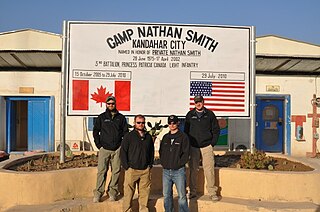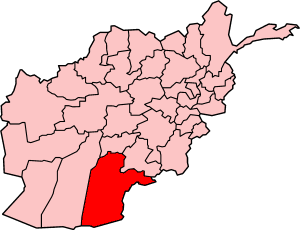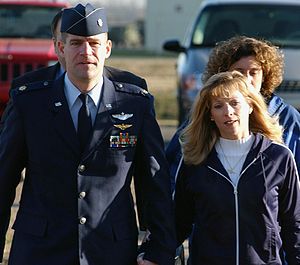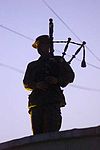
In military terminology, friendly fire or fratricide is an attack by belligerent or neutral forces on friendly troops while attempting to attack enemy/hostile targets. Examples include misidentifying the target as hostile, cross-fire while engaging an enemy, long range ranging errors or inaccuracy. Accidental fire not intended to attack enemy/hostile targets, and deliberate firing on one's own troops for disciplinary reasons, is not called friendly fire, and neither is unintentional harm to civilian or neutral targets, which is sometimes referred to as collateral damage. Training accidents and bloodless incidents also do not qualify as friendly fire in terms of casualty reporting.

The Bell CH-146 Griffon is a multi-role utility helicopter designed by Bell Helicopter Textron as a variant of the Bell 412EP for the Canadian Armed Forces. The CH-146 is used in a wide variety of roles, including aerial firepower, reconnaissance, search and rescue and aero-mobility tasks.

Joseph Gérard Maurice Baril, is a retired General officer in the Canadian Forces, a Military Advisor to the United Nations Secretary-General & head of the Military Division of the Department of Peacekeeping Operations of the United Nations from 1992 to 1997, and Chief of the Defence Staff in Canada from 1997 to 2001.

Throughout the War in Afghanistan, there had been 3,606 coalition deaths in Afghanistan as part of the coalition operations since the invasion in 2001. In this total, the American figure is for deaths "In and Around Afghanistan" which, as defined by the United States Department of Defense, includes some deaths in Pakistan and Uzbekistan and the deaths of 18 CIA operatives.
In military science, force multiplication or a force multiplier is a factor or a combination of factors that gives personnel or weapons the ability to accomplish greater feats than without it. The expected size increase required to have the same effectiveness without that advantage is the multiplication factor. For example, if a technology like GPS enables a force to accomplish the same results as a force five times as large without GPS, then the multiplier is five. Such estimates are used to justify the investment for force multipliers.

Tarnak Farms was an Afghan training camp near Kandahar, which served as a base to Osama bin Laden and his followers from 1998 to 2001.
Canada's role in the Afghanistan War began in late 2001. Canada sent its first element of soldiers secretly in October 2001 from Joint Task Force 2, and the first contingents of regular Canadian Armed Forces (CAF) troops arrived in Afghanistan in January–February 2002. The operations were aimed at identifying and neutralizing Al-Qaeda members in that country and toppling the Taliban regime which was supporting international terrorism. Canada's role in the Afghan conflict grew in 2006 when Canadian troops relieved US forces in Kandahar province, taking command of the multinational brigade in the region during a major Taliban offensive.

Camp Nathan Smith was a former Canadian and later American military base in Kandahar, Afghanistan. Originally, it was an abandoned fruit factory. In November 2003, the site was reconstructed by US Army soldiers of Charlie Battery, 3rd Battalion, 321st Field Artillery Regiment from Fort Bragg, North Carolina. The camp was turned over to the Canadian Army in 2005 and named for Private Nathan Smith of the 3rd Battalion, Princess Patricia's Canadian Light Infantry. Smith was killed in the Tarnak Farm friendly fire incident.

Ahmad Shah Baba International Airport, also referred to as Kandahar International Airport, and by some military officials as Kandahar Airfield, KAF), is located in the Daman District of Kandahar Province in Afghanistan, about 9 NM southeast from the city of Kandahar. It serves as the nation's second main international airport and as one of the largest main operating bases, capable of housing up to 250 aircraft of different sizes. The current head of the airport is Maulvi Fathullah Mansour.

The number of Canadian Forces' fatalities resulting from Canadian military activities in Afghanistan is the largest for any single Canadian military mission since the Korean War between 1950 and 1953. A total of 159 Canadian Forces personnel have been killed in the war since 2002.

Operation Medusa was a Canadian-led offensive during the second Battle of Panjwaii of the War in Afghanistan. The operation was fought primarily by the 1st Battalion, The Royal Canadian Regiment Battle Group and other elements of the International Security Assistance Force, supported by the Afghan National Army and a team from the United States Army's 1st Battalion, 3rd Special Forces Group (Airborne) augmented by C Company, 2nd Battalion, 87th Infantry Regiment of the 10th Mountain Division. Its goal was to establish government control over an area of Kandahar Province centered in the district of Panjwayi some 30 kilometres (19 mi) west of Kandahar city. A tactical victory, it resulted in the deaths of 12 Canadian soldiers; five during the major combat operations, five in bombings, and two in a mortar/RPG attack during the reconstruction phase of the operation. Fourteen British military personnel were also killed when their plane crashed. Despite suffering a brutal battlefield defeat, the Taliban retained their presence in Kandahar province and did not lose their will to fight, leading to the subsequent Operation Falcon Summit. Nonetheless, Operation Medusa was at the time the most significant land battle ever undertaken by NATO.

The 1994 Black Hawk shootdown incident, sometimes referred to as the Black Hawk Incident, was a friendly fire incident over northern Iraq that occurred on 14 April 1994 during Operation Provide Comfort (OPC). The pilots of two United States Air Force (USAF) F-15 fighter aircraft, operating under the control of a USAF airborne warning and control system (AWACS) aircraft, misidentified two United States Army UH-60 Black Hawk helicopters as Iraqi Mil Mi-24 "Hind" helicopters. The F-15 pilots fired on and destroyed both helicopters, killing all 26 military and civilians aboard, including personnel from the United States, United Kingdom, France, Turkey, and the Kurdish community.
A letter of reprimand is a US Department of Defense procedure involving a letter to an employee or service member from their superior that details the wrongful actions of the person and the punishment that can be expected. A Formal Letter of Reprimand is one in which a copy of the letter is kept in the personal service record of the individual.

The following items form a partial timeline of the War in Afghanistan. For events prior to October 7, 2001, see 2001 in Afghanistan.
The following lists events that happened during 2002 in Afghanistan.
The following lists events that happened during 2004 in Afghanistan.
The Friendly fire incident at Sangin was a military incident that took place on March 29, 2006. Afghan insurgents mounted an assault on a forward operating base in Helmand province near the town of Lashkar Gah, which had been opened only six weeks earlier and was staffed by 100 ANA soldiers and their American trainers, using small arms fire, rocket-propelled grenades, and mortars.
The Sarposa Prison attack was a raid on the Sarposa Prison in Kandahar, Afghanistan by Taliban insurgents on June 13, 2008. One of the largest attacks by Afghan insurgents, the raid freed 400-1000 prisoners. As of 2008, prison administration was overseen by Abdul Qabir.

Operation Shahi Tandar, also called Operation Atal, was a series of operations by Coalition troops from the British 42 Commando Royal Marines, Royal Canadian Regiment, 2nd Battalion 2nd Infantry Regiment, and the Afghan national military in central Helmand province and the Western Panjwayi and Western Zhari districts of Kandahar, Afghanistan from January 7–31, 2009.
2003 in Afghanistan. A list of notable incidents in Afghanistan during 2003















